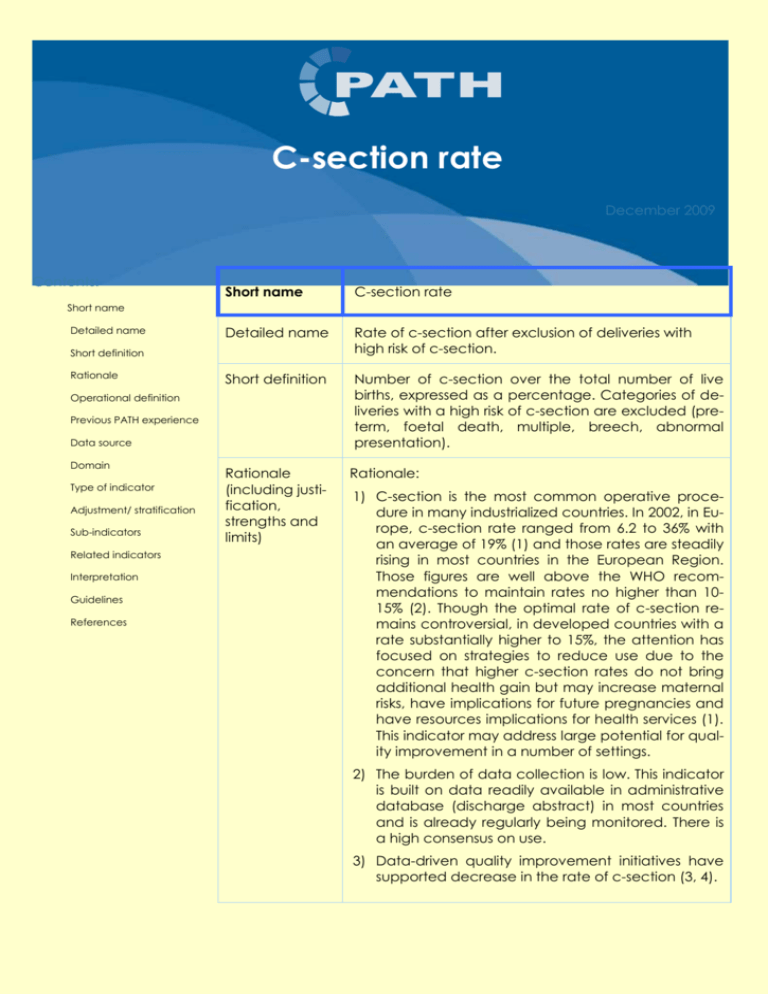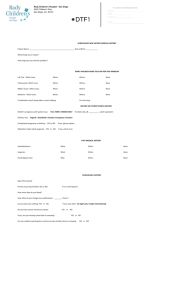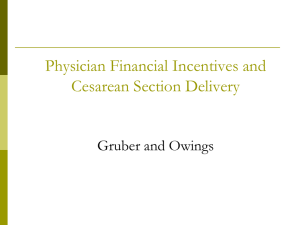1_C-section rate
advertisement

C-section rate December 2009 Contents: 1. Short name C-section rate 2. Detailed name Rate of c-section after exclusion of deliveries with high risk of c-section. 3. Short definition Number of c-section over the total number of live births, expressed as a percentage. Categories of deliveries with a high risk of c-section are excluded (preterm, foetal death, multiple, breech, abnormal presentation). Short name Detailed name Short definition Rationale Operational definition Previous PATH experience Data source Domain Type of indicator Adjustment/ stratification Sub-indicators Related indicators Interpretation Guidelines References 4. Rationale (including justification, strengths and limits) Rationale: 1) C-section is the most common operative procedure in many industrialized countries. In 2002, in Europe, c-section rate ranged from 6.2 to 36% with an average of 19% (1) and those rates are steadily rising in most countries in the European Region. Those figures are well above the WHO recommendations to maintain rates no higher than 1015% (2). Though the optimal rate of c-section remains controversial, in developed countries with a rate substantially higher to 15%, the attention has focused on strategies to reduce use due to the concern that higher c-section rates do not bring additional health gain but may increase maternal risks, have implications for future pregnancies and have resources implications for health services (1). This indicator may address large potential for quality improvement in a number of settings. 2) The burden of data collection is low. This indicator is built on data readily available in administrative database (discharge abstract) in most countries and is already regularly being monitored. There is a high consensus on use. 3) Data-driven quality improvement initiatives have supported decrease in the rate of c-section (3, 4). C-SECTION RATE PAGE 2 7. Operational definition Numerator Total number of deliveries at the denominator with c-section as procedure code (Appendix A) Denominator Total number of deliveries Exclusion Delivery before the 37th week of gestation, foetal death, multiple gestation, breech procedure, abnormal presentation (Appendix B) 8. Previous PATH experience International results and discussion on this indicator can be found in the PATH Newsletter 4. The definition of the c-section indicator is identical for PATH-pilot, PATH-II and PATH’09. However, in PATH-II, the codes for inclusion and exclusion criteria were not specified. In PATH-II, it was suggested to complement the c-section indicator with measures of repeat c-section (number of vaginal deliveries over number of deliveries with previous c-section) and primary c-section (number of c-section over number of primary deliveries). Those two tailored indicators were measured by only few hospitals, on an ad-hoc data collection for a limited time period (and hence limited number of cases that make) and reliability of data was low because of poor understanding of the definition. Hence, it was decided not to include those two tailored indicator in PATH’09. In PATH-II, extremely seldom did hospitals present c-section rates below 10%. Countries 2, 3, and 5 (figure 1, red) tended to have a higher rate (median and mean) as well as a wider dispersion (inter-quartile and standard deviation) compared to countries 1 and 4 (figure 1, blue). This might signal generally better practices in countries 1 and 4 with more homogeneity in the process around a more accepted median or mean rate. If socio-cultural factors (mother-induced c-section for non clinical reasons) can contribute to higher rates in some countries, it does not explain wider variations in those same countries. However, the seemingly better results in countries 1 and 4 might also be explained by homogeneous patient populations in both countries and question the reliability of exclusion criteria identified from administrative database and coding practices in countries 2, 3, and 5. In PATH-II, some hospitals indicated that they were not able to identify the exclusion criteria and some relied on other sources (ward medical document). In PATH-II, mother-induced demand (caesarean delivery on mother request – a request at term in the absence of medical or obstetrical indications) was repeatedly cited in several countries as the main driver for high c-section rates, especially in primary deliveries. This observation confirms numerous commentaries in the medical literature suggesting that consumer demand contributes significantly to continued rise of births by caesarean section internationally (5). However, a review of the literature (2000-2005), highlights that only a small number of women request a c-section. Women’s preferences for c-section varied between 0.3 and 14% with only 3 studies looking directly into these preferences without clinical indication (5). 2 C-SECTION RATE PAGE 3 9. Figure 1: International comparison on average C-section rate within country (min, quartile 1, quartile 3, max, in %) 10. Data source Retrospective data collection on administrative database (discharge abstracts). This indicator is computed for the last 3 years available (2006, 2007, 2008) or the three last available years. If the data is retrieved manually from paper database, the indicator can be computed based on a sample (all deliveries meeting the inclusion and exclusion criteria for the months of e.g. October and February 2006, 2007 and 2008). The PATH Coordinator in the Country should be informed of the sampling procedure. Patient-level data (one record for each patient) is to be sent to the PATH Coordinator in the Country (PCC). For each patient, it includes relevant data for the calculation of the numerator and denominator (specification of inclusion/exclusion criteria) and may also include fields on age of the mother, day/time of delivery, obstetrician, assurance status, etc. Those additional fields are to be discussed at the national level depending on availability of the data (ease to retrieve) and relevance in the context of the country. The coding practices should be discussed among participating hospitals to assess how much the exclusion criteria are specified in the discharge abstracts or if alternative sources of information need to be retrieved on an ad-hoc basis. 11. Domain 12. Type of indicator This indicator is multidimensional as it addresses: - Clinical effectiveness: appropriateness of medical care. - Patient safety: maternal and infant risks related to inappropriate (over and under) use of c-section, physician defensive practice. - Efficiency: higher utilization of resources for C-section than vaginal deliveries. - Responsive governance: access, availability. - Patient centeredness: patient informed choice, physician responsibility in providing balanced information and honouring patient choice for elective c-section. Process measure 3 C-SECTION RATE PAGE 4 13. Adjustment/ stratification No risk-adjustment. Risk-adjustment of caesarean birth rate is hampered by inadequacies in the existing secondary data sources or by the need for extensive chart reviews. Hence, it is not proposed for this purpose. Great caution should be used when interpreting the results as it has been demonstrated that riskadjustment might have a substantial impact on “ranking” hospitals (6, 7). By excluding some deliveries with high risk of c-section, the indicator though is somewhat reducing the variability in patient characteristics. It is suggested to compare the per cent of deliveries excluded at the denominator out of the total number of deliveries. This measure might reflect differences in case-mix or differences in how exclusion criteria are identified and coded in the discharge abstracts or from alternative sources. Hence, it is advisable to compare this measure for different levels of care (e.g. university hospital with neonatal intensive care vs. community hospital). It should then be discussed among the group of participating hospitals if the differences do indeed represent differences of case-mix (complex deliveries oriented to higher level of care). Stratification in subgroups is suggested for benchmarking of c-section rates between units and for auditing results of total c-section rate (Robson Classification) (8, 9). 14. Sub-indicators 15. Related indicators - By age categories of the mother (less 20, 20-35, more 35). - By assurance status of the mother (if relevant to the country). - By elective vs. emergency or proxy: day of the week, time of the day. - By categories for BMI of the mother. - By categories for weight of the newborn. - By parity (primary/not). - Length of stay for patient (mother) at numerator, for patient (mother) at denominator with vaginal delivery, and for all patient (mother) at denominator - Deep vein thrombosis The following indicators are not computed in the frame of PATH’09 but if monitored in the hospital, it might be relevant to relate to the rate of csection: 4 - APGAR score at birth - Antibioprophylaxis before elective c-section C-SECTION RATE PAGE 5 5 C-SECTION RATE PAGE 6 16. Interpretation Limit: Because of the numerous factors that affect the rate of c-section and because there is no “gold standard” on optimal c-section rate, this indicator is difficult to interpret. Both very low rates and very high rates should be scrutinized to understand the reasons for variations. The indicator is difficult to interpret because of the numerous drivers for csection (clinical factors but also cultural and socio-economic factors) and because there is little consensus on optimal c-section rate. This indicator is bidirectional. It means that both high and low rate should be scrutinized. Selection bias is expected (high risk pregnancies concentrated in some facilities, mother choosing their physician to fit their preference in terms of c-section or vaginal delivery). Hence, the best reference point is oneself: It is crucial to look at the evolution over time and understand what factors might affect the trends. Comparison between hospitals within a same country might be relevant to identify some best practices; understand why c-section rate is stable in some hospital while the general trend is a (sharp) increase in c-section. International comparisons are of less value because of the numerous external factors (cultural, socio-economic) that might affect the outcome and which contributions are very difficult to isolate or make explicit. A number of organizational factors such as the type of on-call, the level of paediatric services and the architecture of maternities exert a strong impact and a significant effect on the rate of c-section (10). A number of strategies have a demonstrated impact on reduction of c-section rates such as audit and feedback, quality improvement, and multi-faceted strategies, while quality improvement based on active management of labour showed mixed effect, in a meta-analysis (11). It was also demonstrated that prospective identification of efficient strategies and barriers to changes is necessary to achieve a better adaptation of intervention and to improve clinical practice guidelines implementation (12). With a patient orientation perspective, when comparing c-section, it is suggested to also comparing the procedure to obtain and content and quality of information provided to pregnant mothers on the risks and benefits of c-section. A comparison of the content of the informed consent form is relevant (see for instance, UK Royal College of Obstetricians and Gynaecologists, draft informed consent for c-section – 13). Fear for the mother or for the baby appear to be major factors’ behind a mother’s request for caesarean section, coupled with the belief that caesarean section was safest for the baby (12). Hence, mother counselling is a key in acknowledging women’s preferences while providing most adequate care. Complementary measures for further scrutiny – to investigate outliers: Key specific measures/data to investigate the cause of outliers: 6 C-SECTION RATE PAGE 7 - Subgroup (Robson) analysis - Proportion by category of urgency (immediate threat to the life of the mother or foetus) - maternal or foetal compromise that is not immediately life threatening, - mother need early delivery but no maternal or foetal compromise, Delivery timed to suit the mother and the staff) (classification according to the National Confidential Enquiry into Perioperative Deaths NCEPOD) - Time distribution of c-section (e.g. weekday/weekend) - Surgeon/Obstetrician specific rates - Rate of epidural use - Proportion of failed vaginal delivery after c-section - Labour induction - Presence of unit guidelines for indication of c-section - Presence of material supporting women in informed choice 17. Guidelines NICE guideline: http://www.nice.org.uk/nicemedia/pdf/CG013fullguideline.pdf 18. References (1) Betrán AP, Merialdi M, Lauer JA, Bing-Shun W, Thomas J, Van Look P, Wagner M. Rates of caesarean section: analysis of global, regional and national estimates. Paediatric and Perinatal Epidemiology, 2007;21: 98-113. (2) World Health Organization. Appropriate technology for birth. Lancet 1985; 2:436-437. AHRQ Quality/Patient safety indicators .http://www.qualityindicators.ahrq.gov (3) Kazandjian VA, Lied TR. Cesarean section rates: effects of participation in a performance measurement project. Joint commission Journal on Quality Improvement 1998;24(4):187-196. (4) Main EK. Reducing cesarean birth rates with data driven quality improvement activities. Pediatrics 1999; 103 (1supp.E):374-383. (5) McCourt C, Weaver J, Statham H, Beake S, Gamble J, Creedy DK. Elective cesarean section and decision-making: a critical review of the literature. Birth 2007;34 (3):273-274. 7 C-SECTION RATE PAGE 8 (6) Aaron DC, Harper DL, Shepardson LB, Rosenthal GE. Impact of risk-adjusting cesarean delivery rates when reporting hospital performance. Journal of the American Medical Association 1998;279:1968-1972. (7) Pasternak DP, Pine M, Nolan K, French R. Risk-adjusted measurement of primary cesarean sections: reliable assessment of the quality of obstetrical services. Quality Management in Health Care 1999;8(1):47-54. 1999 (8) Robson MS. Classification of caesarean sections. Fetal and Maternal Medicine Review 2001; 12(1) 23-39) (9) McCarthy FP, Rigg L, Cady L, Cullinane F. A new way of looking at caesarean section births. Australian and New Zealand Journal of Obstetrics and Gynaecology 2007;47:316-320. (10) Naiditch M, Levy G, Chale JJ, Cohen H, Colladon B, Maria B, Nisand I, Papiernik E, Souteyrand P. Cesearean sections in France: impact of organizational factors on different utilization rates (French). Journal de Gynécologie, Obstétrique et Biologie de la Reproduction 1997;26(5):484-495. (11) Chaillet N, Dumont A. Evidence-based strategies for reducing caesarean section rates: a meta-analysis. Birth 2007;34(1):53-64. (12) Chaillet N, Dubé E, Dugas M, Audibert F, Tourigny C, Fraser WD, Dumont A. Evidence-based strategies for implementing guidelines in obstetrics: a systematic review. Birth 2007;34(1):65-79. (13) http://www.rcog.org.uk/womens-health/consultation-documents 8 C-SECTION RATE PAGE 9 Appendix A: Numerator - Inclusions Name INCLUDE - ICD-9-CM Cesarean delivery procedure codes: CLASSICAL C-SECTION 74.0 LOW CERVICAL C-SECTION 74.1 EXTRAPERITONEAL C-SECT 74.2 CESAREAN SECTION NEC 74.4 CESAREAN SECTION NOS 74.99 Appendix A: Numerator - inclusions Name INCLUDE - ICD-10 codes: C-SECTION O82 Appendix B: Denominator - Exclusions ICD-10 Code O30 (O30.0, O30.1, O30.2, O30.8, O30.9) O31.1 Name O32.1 O32.2 O32.3 O32.5 O36.4 O60 O63.2 O64.5 O66.1 O75.6 O81 P01.5 Z37.1 Z37.2 Z37.3 Z37.4 Z37.5 Z37.6 Z37.7 Multiple gestation Complications specific to multiple gestation Maternal care for known or suspected malpresentation of fetus Maternal care for intrauterine death Preterm labour Delayed delivery of second twin, triplet, etc. Obstructed labour due to compound presentation Obstructed labour due to locked twins Delayed delivery after spontaneous or unspecified rupture of membranes Single delivery by forceps and vacuum extractor Fetus and newborn affected by multiple pregnancy Single stillbirth Twins, both liveborn Twins, one liveborn and one stillborn Twins, both stillborn Other multiple births, all liveborn Other multiple births, some liveborn Other multiple births, all stillborn 9 C-SECTION RATE PAGE 10 Appendix B: Denominator - Exclusion Name WHO´s "International Statistical Classification of Diseases and Related Health Problems (ICD-9) Name WHO´s "International Statistical Classification of Diseases and Related Health Problems (ICD-9) EARLY ONSET DELIV-UNSPEC 64420 TRANSV/OBLIQ LIE-UNSPEC 65230 EARLY ONSET DELIVERY-DEL 64421 TRANSVER/OBLIQ LIE-DELIV 65231 TWIN PREGNANCY-UNSPEC 65100 TRANSV/OBLIQ LIE-ANTEPAR 65233 TWIN PREGNANCY-DELIVERED 65101 FACE/BROW UNSPEC 65240 TWIN PREGNANCY-ANTEPART 65103 FACE/BROW PRESENT-DELIV 65241 TRIPLET PREGNANCY-UNSPEC 65110 FACE/BROW PRES-ANTEPART 65243 TRIPLET PREGNANCY-DELIV 65111 MULT GEST MALPRESEN-UNSP 65260 TRIPLET PREG-ANTEPARTUM 65113 MULT GEST MALPRES-DELIV 65261 QUADRUPLET PREG-UNSPEC 65120 MULT GES MALPRES-ANTEPAR 65263 QUADRUPLET PREG-DELIVER 65121 INTRAUTERINE DEATH-UNSP 65640 QUADRUPLET ANTEPART 65123 INTRAUTER DEATH-DELIVER 65641 TWINS W FETAL LOSS-UNSP 65130 INTRAUTER DEATH-ANTEPART 65643 TWINS W FETAL LOSS-DEL 65131 LOCKED TWINS-UNSPECIFIED 66050 TWINS W FETAL LOSS-ANTE 65133 LOCKED TWINS-DELIVERED 66051 TRIPLETS W FET LOSS-UNSP 65140 LOCKED TWINS-ANTEPARTUM 66053 TRIPLETS W FET LOSS-DEL 65141 DELAY DEL 2ND TWIN-UNSP 66230 TRIPLETS W FET LOSS-ANTE 65143 DELAY DEL 2ND TWIN-DELIV 66231 QUADS W FETAL LOSS-UNSP 65150 DELAY DEL 2 TWIN-ANTEPAR 66233 QUADS W FETAL LOSS-DEL 65151 BREECH EXTR NOS-UNSPEC 66960 QUADS W FETAL LOSS-ANTE 65153 BREECH EXTR NOS-DELIVER 66961 MULT GES W FET LOSS-UNSP 65160 MULT PREGNANCY AFF NB 7615 MULT GES W FET LOSS-DEL 65161 DELIVER-SINGLE STILLBORN V271 MULT GES W FET LOSS-ANTE 65163 DELIVER-TWINS, BOTH LIVE V272 MULTI GESTAT NEC-UNSPEC 65180 DEL-TWINS, 1 NB, 1 SB V273 MULTI GESTAT NEC-DELIVER 65181 DELIVER-TWINS, BOTH SB V274 MULTI GEST NEC-ANTEPART 65183 DEL-MULT BIRTH, ALL LIVE V275 MULTI GESTAT NOS-UNSPEC 65190 DEL-MULT BRTH, SOME LIVE V276 MULT GESTATION NOS-DELIV 65191 DEL-MULT BIRTH, ALL SB V277 MULTI GEST NOS-ANTEPART 65193 ICD-9-CM codes BREECH PRESENTAT-UNSPEC 65220 PART BRCH EXTRAC W FORCP 7253 TOT BRCH EXTRAC W FORCEP 72.51 PART BREECH EXTRACT NEC 7254 TOT BREECH EXTRAC NEC 72.52 PREG- BREECH PRESENTAT-DELIVER BREECH PRESENT-ANTEPART 10 65221 65223 breech PRESENT- procedure






